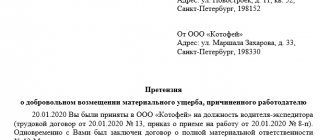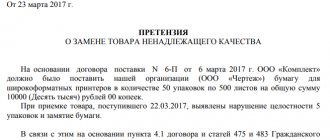Workers use company things: sit at office computers, deliver goods in work vans, dry gel polish under a manicure lamp. Things wear out over time. And if they break due to the fault of employees, this is called “causing damage to the company.”
Typically, entrepreneurs solve the problem informally: they ask the employee to reimburse the expenses. Employees do not always agree and the deduction from their salary is not always enough to pay off. There remains hope for a trial, and it will require evidence. The article will help you understand how to receive compensation formally.
When does an employee/former employee have a claim for property damage?
Labor legislation does not provide for sending an employee such a document as a claim for compensation for material damage.
In practice, filing a claim with a proposal for voluntary compensation precedes going to court. Claims for compensation for material damage are often made against former employees, since serious violations usually result in dismissal. But even as a measure of disciplinary liability, dismissal does not relieve the employee from the obligation to compensate the employer for losses.
Filing a claim is necessarily preceded by an assessment of the possibility of recovering the damage caused and an internal audit (Chapter 39 of the Labor Code of the Russian Federation).
The employee is obliged to compensate the employer for damages if:
1. In total there are 3 circumstances:
- the employee committed unlawful actions (inaction), in other words, violated the law, employment contract, job description, etc.;
- the act was guilty (both intent and negligence are possible);
- the employer has suffered damage that is in direct cause-and-effect relationship with the actions of the employee.
2. There are no circumstances under which the employee’s liability is excluded (Article 239 of the Labor Code of the Russian Federation):
- force majeure (for example, natural disaster);
- ordinary economic risk (paragraph 2, clause 5 of the resolution of the plenum of the RF Armed Forces dated November 16, 2006 No. 52);
- necessary defense (Article 37 of the Criminal Code of the Russian Federation);
- extreme necessity (Article 39 of the Criminal Code of the Russian Federation);
- the employer did not provide proper conditions for storing property.
Limits on amounts collected from employees
Firstly, only direct damage can be demanded from an employee (Article 238 of the Labor Code of the Russian Federation). This is the amount by which the property has decreased/deteriorated, and/or the amount of costs that the employer will be forced to make to restore the previous situation (repairs, payments for damage to third parties).
Lost profits cannot be recovered from an employee. For example, if an employee breaks equipment, then repair costs (direct damage) are subject to recovery. The amount of income lost due to equipment downtime cannot be claimed.
Secondly, as a general rule, the employee must only reimburse an amount not exceeding his average monthly earnings (regardless of the actual amount of damage). Let us remind you that its calculation is made in accordance with the Regulations on the procedure for calculating the average salary, approved. Decree of the Government of the Russian Federation dated December 24, 2007 No. 922. The calculation takes into account the 12 months preceding the month the damage was caused, and if the time of occurrence of the damage cannot be determined, the 12 months preceding the discovery of the losses.
An exception is cases of full financial liability of the employee (an exhaustive list is given in Article 243 of the Labor Code of the Russian Federation). In these cases, the damage can be recovered in full.
Forms of financial liability
The employer's liability is divided into types depending on the grounds on which it is imposed:
- Damage due to which an employee can no longer perform his or her job functions. Regulated by Article 234 of the Labor Code of the Russian Federation.
- Damage to employee property. For example, a manager uses an employee’s car for business purposes. There was an accident. In this case, the employer must pay all costs associated with the repair work. Payment of compensation is regulated by Article 235 of the Labor Code of the Russian Federation.
- Damage associated with delayed wages. Delay in mandatory payments also harms the employee. Payment of compensation is carried out on the basis of Article 236 of the Labor Code of the Russian Federation.
What is the employer’s financial liability for late payment of wages and other amounts (including vacation pay)?
The manager is also obliged to pay compensation in the event of moral damage to an employee.
NOTE! The above list is exhaustive, that is, the employer cannot have any other grounds for financial liability to the employee. Most often, an entrepreneur is held accountable for illegal dismissal, suspension from work, or transfer to another position.
Let's consider all cases when the employer's financial liability arises in more detail.
The concept of “illegal transfer to another job” as a basis for the employer’s liability
Inability to perform one's job functions
The employer is obliged to pay compensation if, through his fault, the employee is unable to perform his job functions. For example, these situations could be:
- Wrongful dismissal or illegal transfer to another position.
- The employer does not want to reinstate the employee to his previous place of work.
- The manager does not give the employee a work book or other documents, and for this reason the person cannot get a new job.
The employer must pay compensation in full. However, it is not always easy to determine the extent of damage. For example, if a person was unable to get a job in a company due to the lack of a work book, the amount of compensation is established based on the following calculation: salary for each day without work.
Damage to employee property
An employee's property refers to his belongings, either owned or leased. Harm means damage, loss, damage, etc. To receive compensation, the employee must submit a corresponding application. The employer is obliged to respond to it within 10 days.
Delay of salary
Salary can mean various payments: salary, vacation pay, sick leave, bonuses. If an employee does not receive wages within the established time frame, he can contact the labor inspectorate. If a person leaves work, he must send an application to the inspectorate within 3 months from the date of delay. If the employee continues to work for the company, there is no time limit for filing an application.
Compensation for damage of this kind includes not only delayed wages, but also charges for each day of delay. The size of these charges is determined based on the Central Bank refinancing rate.
An employee who has not received a salary has the right not to go to work until the delay is eliminated. When the employer is ready to pay the funds, it must give the employee notice in writing. The employee must go to work after receiving the paper.
Moral damage
Moral damage involves causing mental and moral harm to an employee. For example, an employer insulted a person and affected his religious feelings. The amount of compensation and the possibility of its payment are established by agreement of the parties. If this agreement is not reached, the employee may file a lawsuit. You must include evidence of the employee’s suffering and the manager’s guilt in your claim. For example, this could be a certificate confirming the diagnosis of a nervous disease. When establishing the amount of compensation, the degree of moral damage suffered by the person is taken into account. The court takes into account the nuances of a particular case: an agreement between the parties on an acceptable amount can be reached or it can be forced by the court. The court considers the degree of guilt of the employer towards the employee, the amount of moral suffering of the victim, and other circumstances, adhering to the principles of fairness and reasonableness.
Inspection procedure
The purpose of an internal audit is to establish the causes of damage, its extent and those responsible. The law, although not in too much detail, regulates its implementation (Article 247 of the Labor Code of the Russian Federation):
- The employer can create a commission by appropriate order. There are no restrictions on the composition: you can involve both your own employees and specialist consultants under a service agreement.
- An explanation in writing is requested from the allegedly guilty employee. If you refuse to give them, you must draw up a deed.
Although the code is silent about this, upon completion of the inspection, a written document (conclusion or act) is drawn up, where its results are recorded. It is not necessary to familiarize the employee with the inspection materials only if he asks for it.
If the damage does not exceed the average salary of the employee
With such an amount of damage (or if liability is limited by it), the employer has the right, regardless of the employee’s consent, to make deductions from his salary by issuing an appropriate order in any form with reference to the results of the investigation.
Peculiarities:
- the period for issuing the order is 1 month from the date of determining the final amount of damage (i.e., signing the document based on the results of the inspection);
- the order must be familiarized to the employee against his signature;
- You can withhold no more than 20% of each amount paid to the employee (Part 1 of Article 138 of the Labor Code of the Russian Federation).
If an employee wishes to compensate for damage voluntarily, it is better not to resort to deductions, but to agree with him on the form, timing and procedure for compensation for damage. The main thing is that the employee’s consent is documented: in a separate agreement, in a statement, etc.
In the following cases, to compensate for damage even within the limits of average earnings, the employer will have to go to court:
- if the month deadline for issuing a collection order has been missed;
- if the employee quits before the full amount of damage is paid.
Step-by-step instruction
Based on the results of a planned inventory of goods in the warehouse, a shortage of goods was identified:
- set of curtains “Versailles” – 2 pcs. (cost price 8,000 rub./piece).
The financially responsible person (MOL) - Ivanov A.P. was recognized as the culprit.
The shortage is subject to recovery from him at the market value of the goods.
The amount to be collected is 18,000 rubles.
An agreement on full financial responsibility was not concluded with the employee.
The average monthly salary of an employee is 30,000 rubles.
By agreement between the employee and the Organization, the amount of the shortage is withheld for 5 months in equal shares by deduction from the employee’s salary.
On July 31, the employee received a salary of 40,000 rubles, personal income tax amounted to 5,200 rubles.
20% (1/5) of the market value of the shortage is withheld from the employee’s salary - 3,600 rubles.
Let's look at step-by-step instructions for creating an example. PDF
| date | Debit | Credit | Accounting amount | Amount NU | the name of the operation | Documents (reports) in 1C | |
| Dt | CT | ||||||
| Attribution of the amount of the shortfall to the guilty party | |||||||
| July 01 | 73.02 | 94 | 16 000 | 16 000 | 16 000 | Attribution of the amount of the shortfall to the guilty party | Manual entry - Operation |
| 73.02 | 91.01 | 2 000 | 2 000 | 2 000 | Reflection of the difference between the book value and market value of the goods | ||
| Payroll | |||||||
| July 31 | 26 | 70 | 40 000 | 40 000 | 40 000 | Payroll | Payroll |
| 70 | 68.01 | 5 200 | 5 200 | Withholding personal income tax | |||
| 26 | 69.01 | 1 160 | 1 160 | FSS accrual | |||
| 26 | 69.11 | 80 | 80 | FSS accrual (accidental) | |||
| 26 | 69.03.1 | 2 040 | 2 040 | FFOMS accrual | |||
| 26 | 69.02.7 | 8 800 | 8 800 | Pension Fund accrual | |||
| Withholding damage from an employee's salary | |||||||
| July 31 | 70 | 73.02 | 3 600 | Withholding damage from an employee's salary | Manual entry - Operation | ||
For the beginning of the example, see the publication:
- Shortage of goods and materials. The culprit has been identified
Recovery of damages exceeding average earnings
It is possible to forcefully receive an amount of damage exceeding the average monthly income of the perpetrator only through the court. You will also have to go there when the employee stops paying, having initially agreed to voluntary compensation.
The statute of limitations for such claims is 1 year from the date of discovery of the damage or from the day when the employee was supposed to make payment for the damage caused, but did not do so (Part 3 of Article 392 of the Labor Code of the Russian Federation). Missing this deadline in itself does not deprive the employer of the right to go to court. The claim will be denied only if the employee declares that the deadline has been missed (Article 199 of the Civil Code of the Russian Federation).
Before going to court, although it is not necessary, it is advisable to send a claim to the employee.
By the way, the employer has the right to fully or partially exempt the employee from compensation for damage by formalizing his decision with an order. However, there are tax risks associated with assessing the compensation exemption as income to the employee. Accordingly, additional personal income tax assessment is possible (letter of the Ministry of Finance of Russia dated August 22, 2014 No. 03-04-06/42105). The opposite point of view is set out in the letter of the Federal Tax Service dated April 18, 2013 No. ED-4-3/ [email protected]
Payroll
Reflect the deduction in the employee’s payroll using the Payroll document through the Salaries and Personnel section – Salary – All accruals.
Please indicate:
- Salary for - July 2018 , month of accrual;
- from - 07/31/2018 , date of salary calculation.
The tabular part of the document is filled in automatically by clicking the Fill :
- Employee - A.P. Ivanov ;
- Accrued — 40 000;
- Personal income tax - 5,200 , 13% personal income tax on the amount Accrued .
To reflect the amount of damage deducted from the employee’s salary, in the Payroll , create a new Deduction by clicking the Deduction - New Deduction button.
In the Retention , indicate:
- Name - Shortage identified during inventory ;
- Amount - 3,600 , 20% (1/5) of the market value of the shortage identified as a result of the inventory.
A new column Withheld in the tabular part of the Payroll .
in the Withheld - 3,600 .
Postings according to the document
The document generates transactions:
- Dt Kt - calculation of wages to the employee;
- Dt Kt 68.01 - Personal income tax is withheld from the salary;
- Dt Kt 69 - insurance premiums are charged.
In the postings of the Payroll , the deduction of damage from the employee's salary will not be reflected. Withholding in this document must be made so that the amount of damage is reflected in the payroll and pay slip, and is also taken into account when determining the amount to be paid.
Contents of a claim to an employee for damages and its sample
Since the law does not mention the type of document in question, there are no requirements for its content. Typically the claim contains:
- information about the employer;
- Full name and address of the employee;
- a brief description of the situation that resulted in the damage;
- the results of the investigation and a link to documents confirming them;
- proposal for voluntary compensation for damage;
- the period within which it is proposed to compensate for the damage/give a response/appear to the employer for negotiations;
- an indication of the employer's intention to go to court;
- Full name and signature of an authorized person (head of an organization, entrepreneur, other person by proxy).
Documents that document the results of the investigation can be attached to the complaint.
The claim must be handed to the employee against signature, and if this is not possible, it must be sent by mail to the address specified in the employment contract. To confirm sending, the letter is prepared with a notification and a description of the attachment.







